| |
|
|
|
|
|
|
|
|
|
|
| |
| |
田润德
编译文/图 2020-12-11 19:36 |
|
| |
|
|
|
|
| |
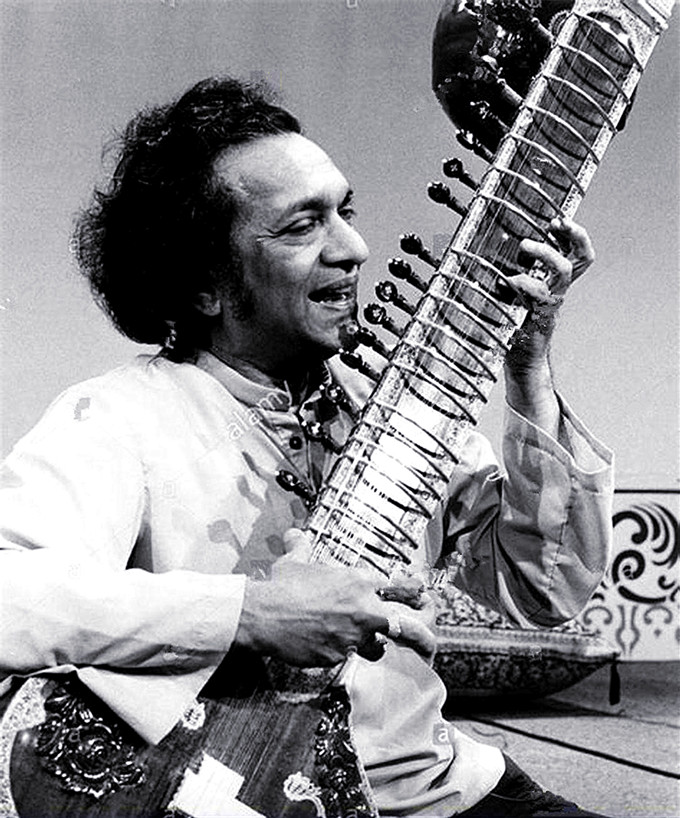 |
|
|
|
| |
拉维·香卡(Ravi Shankar 1920—2012) |
|
|
|
| |
|
|
| |
【印度古典】西塔琴大师拉维·香卡 演奏印度古典乐Raag Khamaj |
|
|
|
| |
Ravi Shankar & Anoushka Shankar Live- Raag Khamaj (1997)
拉维·香卡是令世人景仰的印度音乐的伟大使者、印度古典音乐教父、西塔尔琴大师,“甲壳虫乐队著名吉他手乔治·哈里森的恩师、爵士红伶诺拉·琼斯的父亲。他被世人奉为一代西塔尔琴大师、印度音乐和文化的伟大使者以及不朽的世界音乐家,在弹奏西塔尔琴这种印度最传统最复杂的拥有最神秘音韵的乐器功力上,世人更无出其右。 |
|
|
|
| |
|
|
|
|
| |
音乐历史上的今天
2012年12月11日,印度音乐界的传奇人物拉维·香卡在美国加州去世,享年92岁。
拉维·香卡(Ravi Shankar
1920.04.07——2012.12.11)最令世人景仰的印度音乐的伟大使者、印度古典音乐教父、西塔尔琴大师拉维·香卡,“甲壳虫乐队著名吉他手乔治·哈里森的恩师、爵士红伶诺拉·琼斯的父亲”,而这并非他的真正光环。其实早在半个世纪前他就被世人奉为一代西塔尔琴大师、印度音乐和文化的伟大使者以及不朽的世界音乐家,在弹奏西塔尔琴这种印度最传统最复杂的拥有最神秘音韵的乐器功力上,世人更无出其右。
拉维·香卡(RaviShankar)——甲壳虫乐队著名吉他手乔治·哈里森的恩师,当代爵士红伶诺拉·琼斯的父亲——1920年出生于印度东北部城市Varanaci(旧称Benaras)的一个婆罗门教家庭,其兄乌代·香卡(UdayShankar)是印度著名舞蹈家。拉维10岁时便随印度舞蹈团赴西方演出,在此过程中接触西方音乐,此后,师从印度著名演奏家,作曲家,古鲁(guru,印度教宗教大师)阿拉乌丁汗(UstadAl-laudinKhan)学习印度古典音乐。20世纪40年代拉维开始了演奏生涯,1949-1956年,他主持了全印广播电台乐队,并进行了大量的创作,1956年后,拉维开始在欧美各国巡演并获得巨大的成功,其间他还在洛杉矶建立了一所印度音乐学校。古老而神秘的印度音乐通过拉维的介绍进入了欧美寻常百姓家。1960年,甲壳虫乐队邀请拉维同台演出,此后,西方的摇滚一代借鉴其独特的西塔尔琴演奏技巧使吉他演奏进入了一个新的层次。拉维的西塔尔琴演奏是继承了传统演奏技巧基础上的大胆创新,是他使西塔尔琴这种古老的乐器再次焕发青春。2012年12月11日,印度音乐界的传奇人物拉维·香卡在美国加州去世,享年92岁。[1]2职业生涯编辑活在20世纪60年代的国际范围内的荣誉后,便成为印度音乐和文化的使者。但是只有少数听众能领会这位现代81岁高龄音乐家作品的丰富内涵。拉维·香卡在音乐上的天赋早在他少年时期便已经显现出来,那时他已登上了世界舞台,从纽约的卡内基大厅到巴黎的Champs-Elysees大戏院,他在个个优德的剧团中担任舞者和乐师。这一家族当时就已经赢得了包括俄国芭蕾舞家安娜·帕夫洛娃和爱尔兰作家詹姆斯·乔伊斯等在内的伟大艺术家们的赞赏和钦佩。拉维·香卡和他的家族当时在欧洲和美国长期居住,使得他们渐渐熟知了
亚沙·海飞兹、阿图罗·托斯卡尼尼、帕布罗·卡萨尔斯、艾灵顿公爵、路易斯·阿姆斯壮和卡布·卡洛威等明星。
也许因为较早受艺术的熏陶,加上拉维·香卡超凡的音乐才华、不倦的学习热情和与生俱来的求知欲,使Panditji(“尊敬的大师“,拉维·香卡常被这样尊称)成为一位卓越的音乐大师,同时也是一位卓越的音乐探索家。随着他在Woodstock和
蒙特利(Monterey)音乐节上的一系列亮相,以及他和披头士(尤其是和乔治·哈里森)的合作,无数音乐人将拉维·香卡视为欧美艺人之外放眼世界音乐的一个接触代表。毫无疑问,香客将北印度的古典音乐待到了很多根本没有接触过次种音乐的人耳中,他也运用其非凡的音乐天才和名望将世界各地看似毫无关联的音乐元素融合在一起。将旋律和节奏作为原材料,香卡在音乐厅稀薄的空气与日常生活之间为人们搭了一座桥。他将音乐中的形式和影响大而化之,用实验性的成分来表达和描绘世上最普遍最强烈的人类情感――快乐、渴望、忧愁、奉献、希望和爱。
香卡的三个最具影响力的有跨文化性质的音乐作品都是在独立音乐厂牌下录制的:1978年的《在克里姆林宫》、1990年他和著名作曲家菲利普·格拉斯合作的《通道》以及由他的好友兼学生乔治·哈里森合作录制的《身与心》。受录音技术发展的启发,香卡在Tanamana(《身与心》)这张唱片中,将北印度古乐器西塔尔琴、像琵琶模样的萨罗达琴以及塔布拉手鼓还有其它南印度乐器结合在一起,配合着由合成器与键盘带来电子音乐元素,创作了与他其它唱片一样成功的作品。这张唱片由他与他的好友兼学生乔治·哈里森合作录制,后者负责演奏电竖琴和合成器。香卡的弟妹垃克希米·香卡――印度最优秀最受欢迎的歌手,用自己天籁般的嗓音助香卡一臂之力。他的小儿子舒布霍也在这张唱片中献唱并弹奏西塔尔琴。
他身上有太多光环:印度音乐的伟大使者,印度古典音乐教父,西塔尔琴大师,甲壳虫乐队吉他手乔治·哈里森的恩师,三次获得格莱美奖、一次获得奥斯卡最佳音乐奖提名,他还是印度上院议员、慈善家、作家……
香卡先后三次荣获格莱美奖,为电影《圣雄甘地》配乐获奥斯卡提名,还获得印度国家勋章、威尼斯电影节特别奖、柏林电影节银熊奖、法国“最高平民奖”、英国“荣誉爵士”等,并拥有15个荣誉博士学位。
西塔尔琴
西塔尔琴是印度北部的一种传统乐器,长约90公分,其共鸣箱由镶有红木面板的大葫芦制成,琴顶往往还固定一个小葫芦,以达到加强琴体共鸣的作用。西塔尔琴一般有约有20多个品,18-20根弦,其中7根主弦中,有4根为演奏旋律用弦,定音C,G,c,f,另3根为主音共鸣低音弦,用以突出音乐节奏,另外在其拱形音品的下方还有11-13根与主弦平行的共鸣弦,演奏时这些共鸣弦随着主弦变化而发出自然泛音。不难见得,西塔尔琴结构及其复杂,演奏难度相当之大,远胜过东西方的任何一种弦乐器。但是西塔尔琴音色柔美,其高度发展的演奏技巧和丰富多样的表现手法,使其既能走出缓慢悠扬的抒情旋律,又能奏出快速动感的舞蹈节奏,是人类音乐宝库中不可多得的一件伟大的乐器。拉维·香卡从艺七十多年,在演奏、创作、理论诸方面都有建树,出版发行了大量的CD、VCD、DVD,创作了几十首风格各异的拉格以及大量的电影音乐、舞蹈音乐等。无论是他特立独行的演奏个性,还是求新求变的创作风格,都对印度音乐的发展产生了重要影响。
今日视频:1、西塔琴大师拉维·香卡 演奏印度古典乐Raag Khamaj;2、印度国宝级大师拉维·香卡与阿拉拉卡共同解说及示范南亚锣鼓经;3、梅纽因与拉维·香卡合作
演奏印度古典音乐;4、印度古典音乐教父——西塔琴大师
拉维·香卡的纪录片(1970)。
|
|
|
|
| |
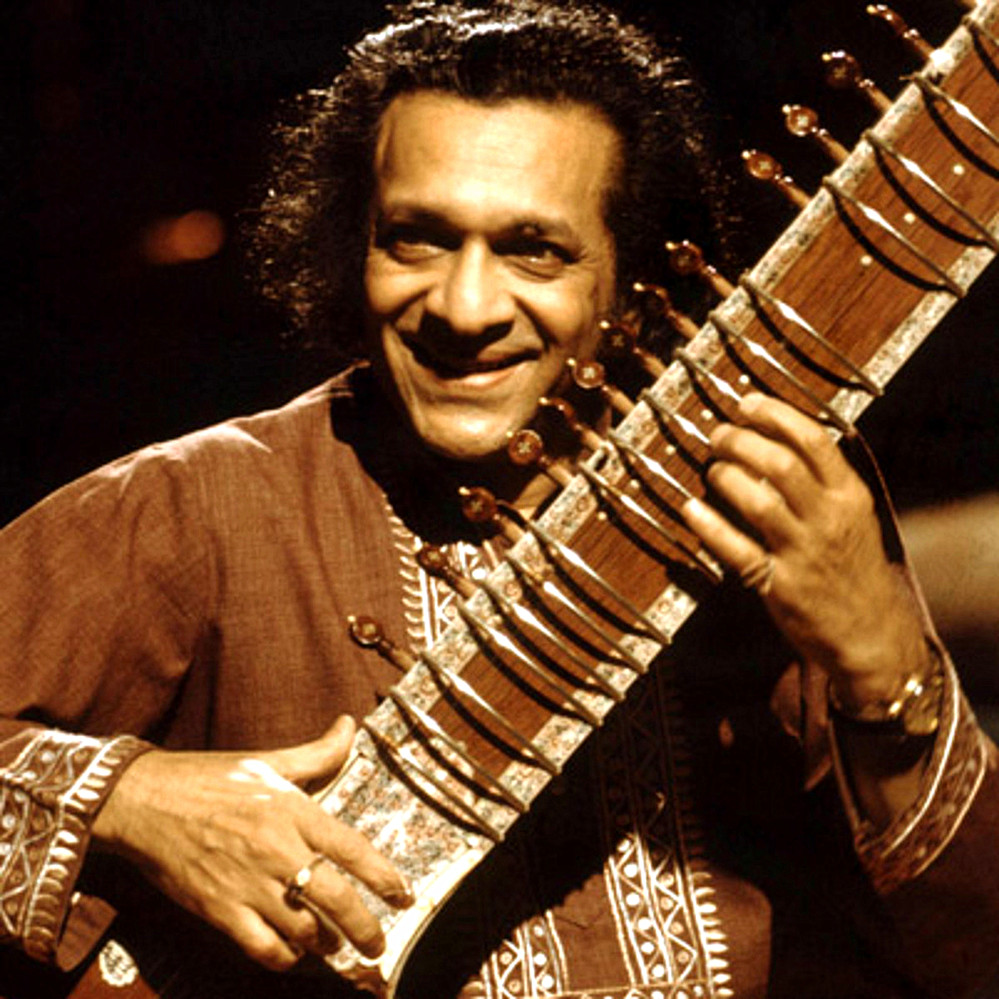 |
|
| |
年轻的拉维·香卡(Ravi Shankar ) |
|
|
|
| |
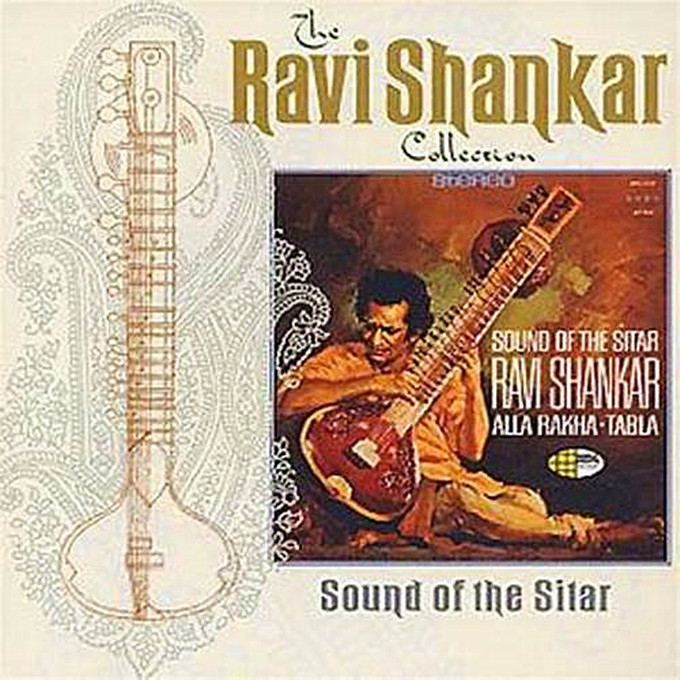 |
|
| |
拉维·香卡从艺七十多年,在演奏、创作、理论诸方面都有建树,出版发行了大量的CD、VCD、DVD,创作了几十首风格各异的拉格以及大量的电影音乐、舞蹈音乐等。这是拉维·香卡(Ravi
Shankar )灌录从唱片《锡塔琴的声音》,他的音乐传遍了世界各地,受到人们的喜爱。 |
|
|
|
| |
Ravi Shankar has been an
artist for more than 70 years. He has made great achievements in
performance, creation and theory. He has published a large number of
CDS, VCDS and DVDS, and created dozens of raga songs with different
styles, as well as a large number of film music and dance music.This is
a recording by Ravi Shankar from the record "The Sound of sitar," and
his music has spread all over the world and is loved by people. |
|
|
|
| |
 |
|
| |
帕迪特·拉维·香卡诞辰纪念日:关于这位传奇西塔尔琴演奏家的一切
香卡在 18 岁时放弃了舞蹈生涯,随后在乌斯塔德·阿卢杜丁·汗的指导下学习萨特里长达七年之久。1939 年 12
月,他在与西塔尔演奏大师阿里·阿克巴尔·汗的二重奏表演中首次登台演奏西塔尔。 |
|
|
|
| |
Pandit Ravi Shankar Birth
Anniversary: All about the legendary Sitarist
Shankar studied the sitar for seven years under Ustad Allauddin Khan
after quitting dance at the age of 18. He made his sitar debut in
December 1939 while playing a jugalbandi (duet) alongside sitar virtuoso
Ali Akbar Khan. |
|
|
|
| |
拉维·香卡个人作品著作: |
|
|
|
| |
《我的音乐,我的生活》(MyLifeMyMusic),1968年在美国洛杉矶出版。主要是为西方普通读者而写的一本英文版书籍,以拉维-香卡音乐经历为线索,同时将印度音乐知识贯穿其中。《拉格与情感》(RagaAnurag),1978年由音乐表演艺术研究院(RIMPA)出版,是一本用孟加拉语撰写的书籍。书中序言部分是记者桑卡尔拉勒录音采访香卡的记录。针对音乐专业的读者,香卡讲述了西塔尔琴以及印度传统音乐的发展,在较深层次上探讨了印度音乐和音乐家。《学习印度音乐》(LearnIndiaMusic),1979年美国出版。这是一本配有三盘磁带的书籍,作者以一种系统的方法讲授如何学习印度音乐,改变了印度音乐史以口头传授的这一古老方式,用书面文字和演奏实例的音响取而代之,这是印度艺术教育领域中的新发展。
自传性电影:《拉格》(Rage),1968年美国拍摄。
《拉维·香卡肖像》(RaviShankarInPor-trait),2000年英国BBC拍摄。
拉维·香卡
《拉维·香卡在两个世界之间》(RaviShankar:betweenTwoWorld),2000年美国和法国拍摄。
从20世纪50年代到2007年间他出版的具代表性的CD包括:《MenuhinMeetsShankar》(东西方相遇之一,1966)《WestMeetsEast》(东西方相遇之二,1967)《WestMeetsEast》(东西方相遇之三,1976)《concertoforSitarandOrchestraNo.1》(西塔尔第一协奏曲,1971)
《concertoforSitarandOrchestraNo.2》(西塔尔第二协奏曲,1982)
《RaviShankarinKremlin》(1988)
《sitar》[Oriental](1989)
《Passages》(1991)
中央音乐学院陈自明教授曾于1982年6月在《乐器》杂志发表一篇《西塔尔琴与拉维·香卡》的文章。可以说,这是中国第一篇专门介绍香卡的文章。1983年拉维·香卡访问中国,在北京和上海分别举行了演出和讲学。针对这次访华,陈自明在1984年第1期《人民音乐》上再次发表文章《拉维·香卡——来自印度的音乐使者》。他在文中写道:“拉维·香卡在中央音乐学院的讲学也是十分成功的,他以朴实无华的语言向听众解释了印度古典音乐的两大支柱——‘拉格’和‘塔拉’,并且以自己的歌声和乐器介绍了‘拉格’的实例。接着他又同鼓手米什拉先生合作,用拟声语和鼓声的实例介绍了‘塔拉’。最后他还亲自教大家练习印度的各种‘塔拉’,取得了很好的效果。”“他也期待在不久的将来能用西塔尔与中国民族乐器进行合作,从而促成一次‘东方(音乐)与东方(音乐)的相遇’。”至此,中国音乐界才有更多的学者开始了解这位著名的印度西塔尔琴演奏大师。虽然关注度有所增加,但拉维·香卡的中文资料仍旧不足,只是在一些书籍或教材中有少量的介绍和评述,缺乏深入的分析和全方位的论述,专题性的研究则更是一项空白。
香卡离世的噩耗,无数印度人为之扼腕叹息。总理辛格第一时间给香卡的遗孀发去吊唁信:“拉维·香卡大师的离去使印度失去了一个杰出的儿子,音乐界陨落了一颗璀璨的巨星……他的伟大精神随同他的音乐跨过了国家的界限,超越了艺术的疆界,惠及整个人类文明。”
拉维·香卡的音乐是集民族性、传统性与融合性为一体的音乐。在半个多世纪的世界巡回演艺生涯中,他不仅把印度民族精神和民族文化渗透于自己无数次的艺术活动之中,而且还把印度传统音乐推向了世界。印度总理尼赫鲁曾公开表示:“年轻的拉维·香卡正在做一件好事,他作为‘文化大使’通过音乐向西方展现印度。”
时至今日,他虽已年近九旬高龄,但仍然活跃在世界音乐舞台上,他是印度音乐杰出的继承者、阐释者、传播者。
作为学生,他在自己父亲般的恩师印度著名音乐家阿拉乌汀·汗的倾心教导下,度过了七年的“学徒生涯”。老师所给予他的无数教诲,让他终身难忘。以他自己在电影《拉格》(1968年)中所说:“在我们音乐的世界里,永远不能说已完成了学习,因为向老师学习的过程是永无止境的。”
作为演奏家,他以自己卓越的演出实践,使西塔尔琴这一古老的印度乐器在国际舞台上占有一席之地。他精湛的演技、高度的修养和完全投入音乐的精神使观众为之倾倒。他是世界音乐舞台上最伟大的演奏家之一。
作为作曲家,他的创作涉及多种体裁。包括民族器乐、舞蹈、电影、爱国歌曲,以及用印度民族乐器与西洋管弦乐合作的音乐等。在他创作的背后,包含着他对传统古典音乐所积蕴的深厚造诣,体现出他在西方文化影响下进行文化融合的创新探索。他的音乐不失印度音乐的传统性、民族性和纯洁性,他是世界音乐最卓越的实践者之一。
作为教育家,他努力地教授印度音乐。20世纪60年代起,他先后在孟买和洛杉矶创办自己的学校——金纳拉(Kinnara)音乐学校。他是一个具有幽默感、亲切而有热情的老师,在和学生的交流中,他无拘无束,和蔼体贴,他无微不至的关心是学生们永远都不会忘记的,他是印度最优秀的“古儒”(Guru,印度对老师的称谓)之一。
作为音乐家,香卡出版了大量的唱片、磁带、CD、VCD等,1968年和2000年两次拍摄自传体电影《拉格》和《拉维·香卡在两个世界之间》。英国BBC于世纪之交的2000年特别推出一套《拉维·香卡肖像》,这些无疑都是世界音乐文化发展史上珍贵的史料。
作为成功者,拉维·香卡获得了无数的奖项与荣誉。20世纪50年代为电影《椅子的故事》制作的音乐在威尼斯电影节上获得了特别奖。60年代,由于他对印度音乐和文化做出了突出贡献,获得“印度总统奖”,他和梅纽因合作的唱片《东西方相遇》获格莱美音乐奖。70年代,他的专辑《为孟加拉国人举行的音乐会》荣获“金碟奖”。80年代,为电影《圣雄甘地》配乐荣获奥斯卡提名;为电影《卡布里瓦拉》(Kabuliwala)配乐获得柏林电影节银熊奖;1986至1992年他成为印度国会上议院成员。90年代,在新德里荣获“自由精神奖”;在瑞典获“地球大使”水晶奖。在20世纪中,他前后荣获14个荣誉博士学位。进入21世纪以来,他再获法国“最高平民奖”、英国“荣誉爵士”、美国加利福尼亚州立大学艺术博士,2002年他第三次获格莱美音乐金碟奖。他是最成功的印度音乐家之一。
作为普通人,他是一个诚实、智慧、有思想、幽默、有灵感并乐观的传奇式人物。他的女儿安努什卡在自己的书中写到:“爸爸是一个近乎完美的人——天才、演奏家、作曲家、教育家、慈善家……面对这些他总是那么的不以为然,这正是他最伟大的品质之所在。”
从1930年至2005年,拉维·香卡举办了近千场的音乐会,参加了不计其数的世界音乐文化交流活动,与东西方的音乐家共同创作、表演、研讨、沟通,架起世界音乐交流之桥梁。系统而深入地研究拉维,香卡的艺术生涯和艺术成就,不仅让人们更加认识印度音乐、认识拉维·香卡,而且对如何保持中国的传统音乐、如何在世界上进一步弘扬中国音乐文化具有借鉴意义。 |
|
|
|
| |
 |
|
| |
拉维·香卡(Ravi Shankar )在波士顿的演奏会 |
|
|
|
| |
拉维·香卡是如何创造音乐历史的 |
|
|
|
| |
1967-68年冬天,我去了波士顿的拉维·香卡(RaviShankar)演唱会。礼堂里挤满了印度古典音乐爱好者,好奇者,潮流追随者以及大量嬉皮士和摇滚迷。我估计,
十有八九都不到30岁,其中大多数人居住在称为“反文化”的新环境中。经过艰苦的尝试,香卡(Shankar)成为了一位超级巨星,他在6月的“爱之夏”(Summer
of Love)开幕之际参加了蒙特利流行音乐节(Monterey Pop
Festival),这是他的历史性演出。他的表演引起了无数人的关注,第二年D. A.
Pennebaker开创性的纪录片《蒙特利·波普》(Monterey
Pop)发行后,他的表演更是震撼人心。影片包括Simon和Garfunkel,Jefferson飞机,Who,Otis
Redding,Janis Joplin和Jimi
Hendrix等偶像的表演,他们以着火的方式点燃吉他并将其粉碎成碎片。但是,观众们对电影的高潮时刻惊叹不已,离开了剧院,这是香卡(Shankar)令人惊叹的四个小时片长约18分钟。
在开始波士顿演出之前,香卡向观众致辞。他说,他已经了解到年轻人在参加音乐会之前正在吸毒,认为如果他们被扔石头,他们会更欣赏音乐。他不喜欢这个主意。他说,那时大约48岁,因此是婴儿潮一代中的一位年长者,他说我们应该以干净的神经系统来欣赏音乐,而如果我们想扩大思维,我们应该通过冥想和瑜伽来做到。实际上,您可以听到集体的“
Bummer”!源于失望者大脑的改变。 |
|
|
|
| |
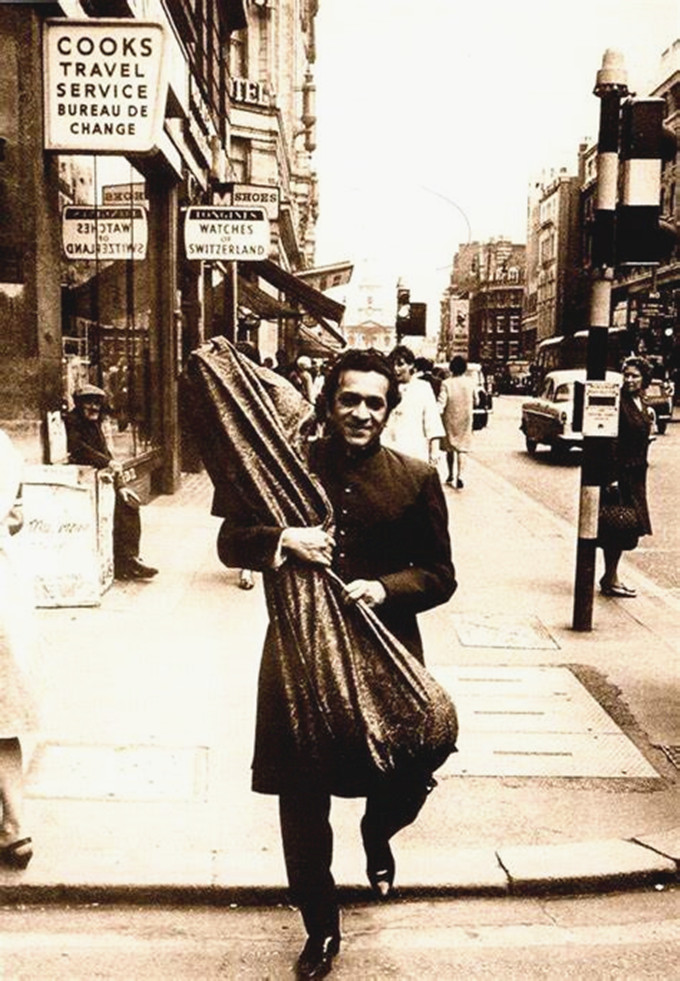 |
|
|
|
| |
1956年后,拉维开始在欧美各国巡演并获得巨大的成功,其间他还在洛杉矶建立了一所印度音乐学校,他把他的一生都交给了他热爱的印度和古典音乐事业。 |
|
|
|
| |
After 1956, Ravi began to
tour Europe and the United States to great success, during which he also
established an Indian music school in Los Angeles, and he devoted his
life to his love of India and classical music. |
|
|
|
| |
HOW RAVI SHANKAR
MADE MUSICAL HISTORY
In the winter of 1967-68, I went to a Ravi Shankar concert in Boston.
The auditorium was packed with aficionados of Indian classical music,
curiosity seekers, trend followers, and a boatload of hippies and rock
fans. Nine of ten, I would estimate, were under 30, and most of them
inhabited the new landscape called ‘counterculture’. Without trying, and
with considerable reluctance, Shankar had become a superstar, having
made his historic appearance at the Monterey Pop Festival that June, at
the onset of the Summer of Love. His performance had blown thousands of
minds, and many times more were blown when D. A. Pennebaker’s
groundbreaking documentary Monterey Pop was released the following year.
The film included performances by icons like Simon & Garfunkel, the
Jefferson Airplane, the Who, Otis Redding, Janis Joplin and Jimi
Hendrix, who famously lit his guitar on fire and smashed it to pieces.
But audiences left the theater with their minds blown by the climactic
moments of the film, about 18 minutes of Shankar’s stunning four-hour
set.
Before starting that Boston performance, Shankar addressed the audience.
He said he'd learned that young people were taking drugs before coming
to his concerts, thinking they would appreciate the music more if they
were stoned. He did not like that idea. About 48 at the time, and
therefore an elder to the baby boomers in attendance, he said we should
come to the music with clean nervous systems, and if we wanted to expand
our minds we should do so with meditation and yoga. You could
practically hear a collective "Bummer!" emanating from the altered
brains of the disappointed. |
|
|
|
| |
但是其他人有不同的反应。对他们来说,香卡的声明证实了他们开始怀疑的事情:迷幻的经历是通向意识状态的窗口,而意识状态可以通过同样古老的智慧得以培育出来,这种古老的智慧可以通过培养,甚至兴起于我们的音乐来获得。来听听。伟大的小提琴手耶胡迪·梅纽因(Yehud
Menuhin)在50年代中期首次邀请香卡(Shankar)来到西方,他在回忆录中说,印度音乐的目的是“使一个人对其中的无限敏感,使人的呼吸与空间,随着宇宙的振动而振动。”
许多听众都感到振动的转变及其产生的欣快感引发了对印度精神宝藏的广泛探索。出于这个原因,拉维·香卡(Ravi
Shankar)对当代精神的贡献以及他非凡的技巧,作为音乐会和电影音乐的作曲家的高产以及在促进该国的音乐传统和世界音乐方面的作用都应引起人们的广泛关注。 |
|
|
|
| |
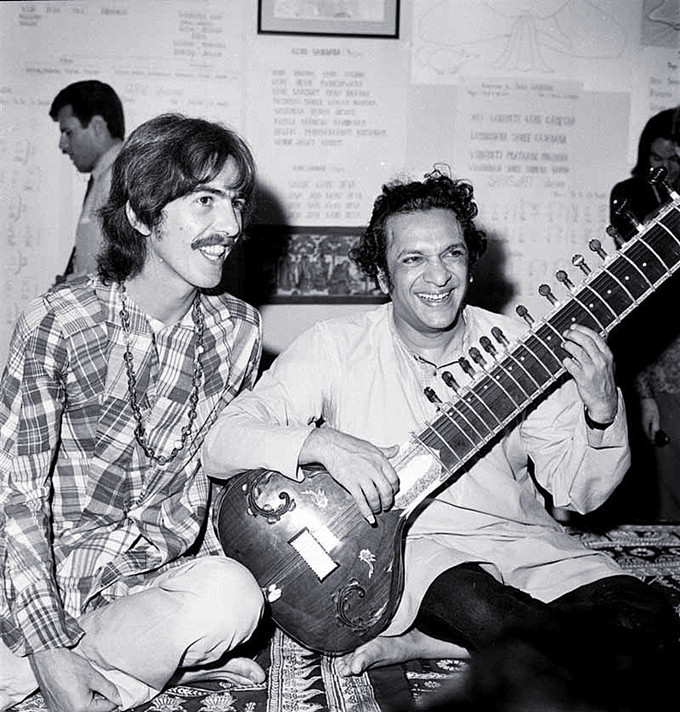 |
|
|
|
| |
拉维·香卡(Ravi Shankar )和他的学生哈里森(Shankar-Harrison) |
|
|
|
| |
香卡和哈里森(Shankar-Harrison)的关系直接导致了1967年8月的分水岭,当时甲壳虫乐队遇到了Maharishi
Mahesh Yogi,并进行了超然冥想,不久之后,他们在他的恒河上的住所里住了很久。
音乐方面,主要结果是《白色专辑》。
从精神上讲,它导致了冥想和印度灵性其他表达方式的主流化,包括今天的哈他瑜伽和契丹的繁荣,乔治与拉达·克里希纳·邓波(Radha
Krishna Temple)在流行地图上的传统诵经,他与野兔·克里希纳(Hare
Krishna)奉献者/音乐家制作的1970年专辑 。
音乐,友谊,协作和精神转型的强大结合构成了独特的遗产。 潘迪特·拉维·香卡(Pandit Ravi
Shankar)的非凡人生,应因其对西方精神转型的贡献以及其惊人的技巧和在将印度古典音乐带入世界其他地区所发挥的无与伦比的作用而受到赞扬。 |
|
|
|
| |
 |
|
| |
拉维·香卡(Ravi Shankar )和他的学生哈里森(Shankar-Harrison) |
|
|
|
| |
The
Shankar-Harrison bond led directly to the watershed
moment in Aug., 1967, when the Beatles met Maharishi
Mahesh Yogi and took up Transcendental Meditation,
and a short while later their famous sojourn at his
ashram on the Ganges. Musically, the chief result
was the White Album. Spiritually, it led to the
mainstreaming of meditation and other expressions of
Indian spirituality, including today's boom in hatha
yoga and kirtan, the traditional chanting that
George put on the pop map withRadha Krishna Temple,
the 1970 album he produced with Hare Krishna
devotee/musicians.
That powerful mix of music, friendship,
collaboration, and spiritual transformation
constitutes a unique legacy. The remarkable life of
Pandit Ravi Shankar should be celebrated as much for
its contribution to the spiritual transformation of
the West as for his astonishing virtuosity and his
unmatched role in bringing classical Indian music to
the rest of the world. |
|
|
|
| |
 |
|
| |
德里:4 月 7
日,印度国家银行在其社交媒体平台上发布了已故萨特里琴大师帕迪特·拉维·香卡的图片,以纪念他的诞辰纪念日。
然而,令所有人震惊的是,这张图片展示的并非沙克尔弹奏萨特里琴的画面,而是吉他。
该帖子配有如下说明:“印度国家银行向萨特里琴大师兼印度国宝奖得主帕迪特·拉维·香卡致敬”,并附有话题标签“#SBICelebratesTheLegends”。
尽管帖子中所展示的人物与这位备受尊敬的音乐家有相似之处,但网络用户仍持怀疑态度。一些人批评这张图片,称其可能是由人工智能生成的,还有一位用户表示他们找不到拉维·沙克尔弹奏吉他的任何照片。
因此,印度国家银行迅速从其社交媒体平台上删除了这张图片。
这并非品牌因使用未经同意且面部特征与他人相似的由生成式人工智能创作的图像而遭遇麻烦的首例。 |
|
|
|
| |
Delhi: On April 7,
SBI posted an image of the late sitar maestro Pandit Ravi Shankar on the
bank’s social media platforms to commemorate his birth anniversary.
However, to everyone’s shock, the image didn’t show Shankar playing the
sitar, but instead, the guitar.
The post featured the caption: "SBI pays homage to the Sitar Maestro and
Bharat Ratna Awardee Pandit Ravi Shankar," accompanied by the hashtag
"#SBICelebratesTheLegends".
While the individual depicted in the post bore a resemblance to the
esteemed musical figure, online users remained sceptical. Some
criticised the image, suggesting it was AI-generated, while one user
mentioned they were unable to locate any photographs of Ravi Shankar
playing the guitar.
Consequently, SBI promptly removed the image from its social media
platforms.
This isn't the first instance of brands encountering trouble for using
GenAI-generated creatives featuring faces resembling individuals without
their consent. |
|
|
|
| |
|
|
|
|
| |
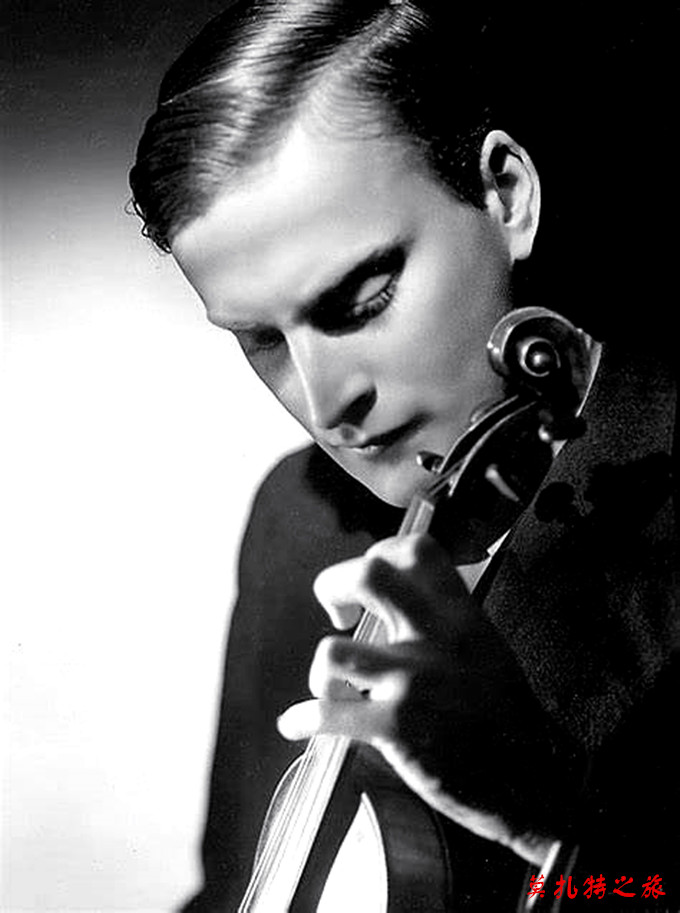 |
|
|
|
| |
耶胡迪·梅纽因(Yehudi Menuhin
1916-1999) |
|
|
|
| |
很少有哪一位小提琴家能比年轻的耶胡迪·梅纽因对音乐世界有更大的影响了。在他的手指有足够的力量为小提琴调音之前,他的名字已经在国际上广为传播。当1978年6月26日为庆祝他舞台生涯五十周年在费城举行音乐会时,詹姆斯·费尔顿在《晚报》上写道:
他看上去的确是一位永不衰老的人,永远谦虚,而且仍然是一位避免炫耀技术,力求挖掘旋律之美的高雅小提琴家。他没有像许多小提琴家那样把小提琴的标准音有意地调高一点,以便使自己的声音更突出。他并没有拼命用力地运弓,以便把自己的热情狂热化。他选择演奏门德尔松的小提琴协奏曲是非常适合的……梅纽因把这首乐曲处理得文雅、亲切,有时面带一点微笑,似乎表明他与他的小提琴是亲密的伙伴......他也没有以炫技的手法来演奏协奏曲的华彩乐段,而是经过认真思考后把它处理成与整首协奏曲总的抒情情性相一致。这是一场很得体的演出。而且梅纽因还特别坚持与舞台上所有的演奏员一起共同分享听众们的掌声,就好像他们刚才一起演奏的是室内一样。
耶胡迪·梅纽因(Yehudi
Menuhin,1916年4月22日-1999年3月12日),美国小提琴家,犹太人。7岁在其师帕辛格指挥的旧金山交响乐队伴奏下演出拉罗《西班牙交响曲》,被誉为“神童”。曾在纽约交响乐队伴奏下演出贝多芬小提琴家的行列。与欧洲、美国的主要交响乐队伴奏下演出贝多芬小提琴协奏曲,此后在卡内基大厅举行独奏会,从而进入世界著名小提琴家的行列。战后访问过苏联、以色列、日本、印度,对东西方文化交流起过一定作用。七十年代出版了他的自传《未完的历程》。他的演奏具有辉煌的技巧、独特的气质和动人的魅力。 |
|
|
|
| |
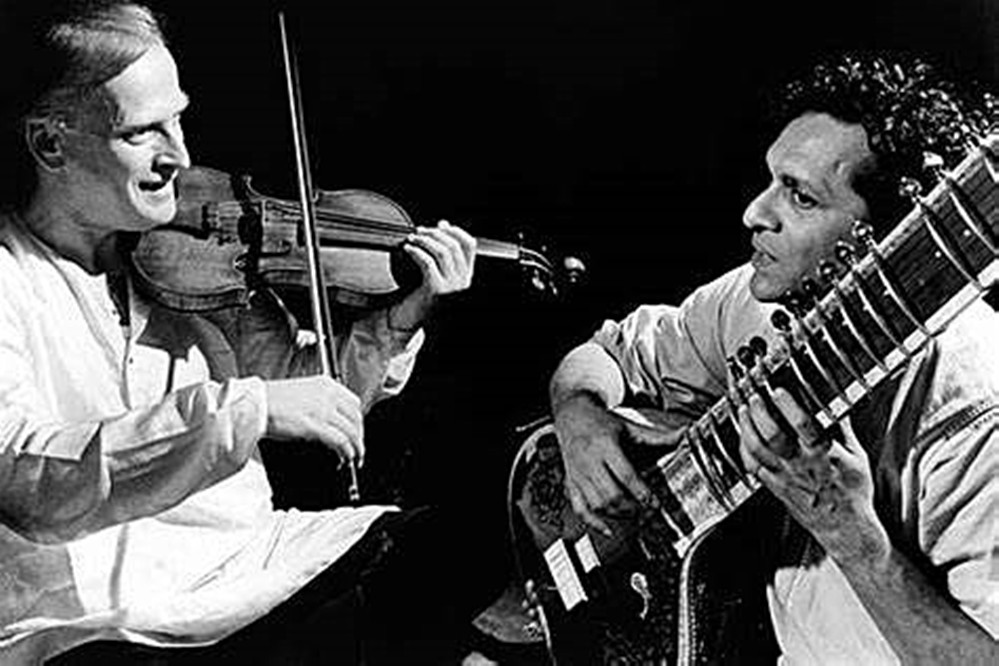 |
|
| |
|
耶胡迪·梅纽因和拉维香卡在演奏印度音乐 |
|
Yehudi Menuhin and ravishankar are playing Indian music |
|
|
|
|
| |
He does seem to be
a man who never grows old, always modest, and still an elegant violinist
who avoids showmanship and seeks to tap into melodic beauty.He did not
deliberately raise the standard note of the violin, as many violinists
do, to make his voice more prominent.He did not bend his bow as hard as
he could to turn his enthusiasm into enthusiasm.His choice of playing
Mendelssohn's violin concerto was very fitting...Menuhin handled the
music in a gentle and friendly way, sometimes with a smile, as if he and
his violin were intimate companions...He also did not play the
concerto's cadenza in a showy way, but rather, after careful
consideration, processed it into something consistent with the overall
lyricism of the concerto.It was a decent performance.Menuhin also made a
point of sharing the audience's applause with all the players on the
stage, as if they had been playing together indoors.
Yehudi Menuhin (22 April 1916 -- 12 March 1999) was an American
violinist and Jew.At the age of seven, she was praised as a "child
prodigy" when she performed raro's "Spanish symphony" with the San
Francisco symphony orchestra under the direction of her division
passinger.Performed as a Beethoven violinist with the New York symphony
orchestra.Performing Beethoven's violin concerto with major orchestras
from Europe and the United States, followed by a recital at Carnegie
Hall, he entered the ranks of the world's most famous violinists.After
the war, he visited the Soviet union, Israel, Japan and India, which
played a certain role in the cultural exchanges between the east and the
west.In the 1970s he published his autobiography, the unfinished
journey.His performance has brilliant skill, unique temperament and
moving charm. |
|
|
|
| |
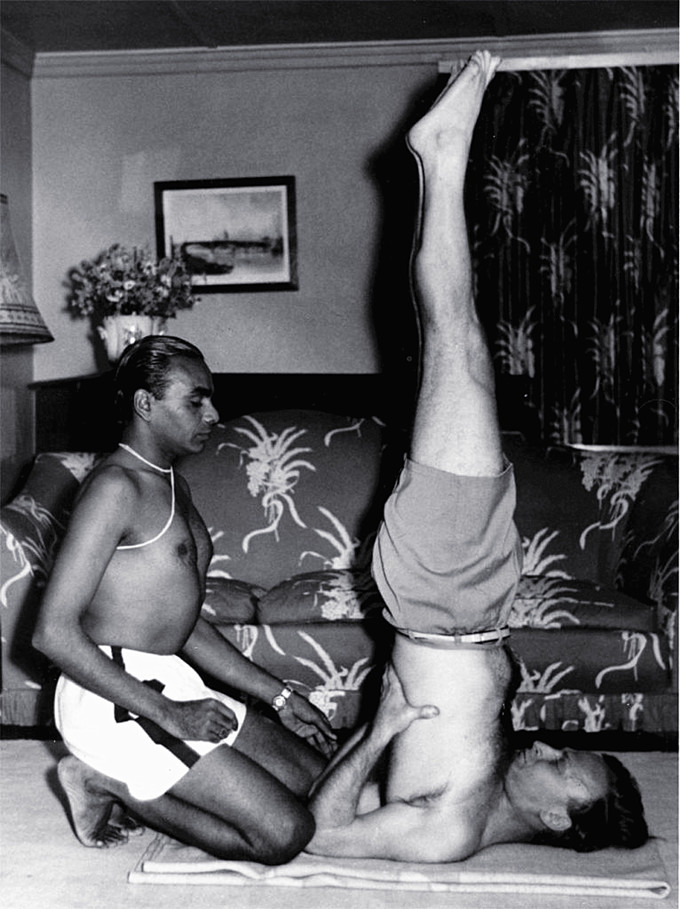 |
|
|
|
| |
印度瑜伽大师埃因嘎(B.
K. S. Iyengar)在指导梅纽因训练 |
|
|
|
| |
50年代后期,梅纽因因为练琴方法不当,职业病开始发作,曾因此中断了几次演出,正是运用了后来瑜伽功的练习,对他的身体的恢复受益匪浅,使他不但重返舞台,而且功力不但不减,而且还练习了一身绝技。 |
|
|
|
| |
In the
late 1950s, menueuw interrupted several performances due to the
onset of occupational diseases caused by excessive fatigue of
practicing the piano. It was the use of the later yoga exercises
that benefited his physical recovery and enabled him to not only
return to the stage, but also to practice his unique skills. |
|
|
|
| |
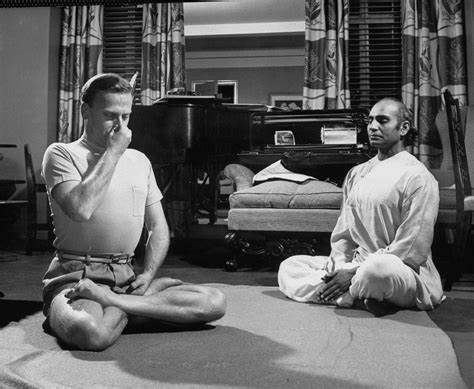 |
|
|
|
| |
印度瑜伽大师埃因嘎(B.
K. S. Iyengar)在指导梅纽因训练
瑜伽和冥想 |
|
|
|
| |
印度瑜伽大师埃因嘎(B.
K. S. Iyengar)在指导梅纽因训练
瑜伽和冥想;印度的西塔尔琴大师拉维·香卡也曾经说过:“我们应该以干净的神经系统来欣赏音乐,而如果我们想扩大思维,我们应该通过冥想和瑜伽来做到”。 |
|
|
|
| |
B. K. S.
Iyengar, the Indian yoga master, instructs Menuhin in yoga and
meditation;The Indian sitar guru Ravi Shankar also once said,
"We should enjoy music with a clean nervous system, and if we
want to broaden our mind, we should do so through meditation and
yoga." |
|
|
|
| |
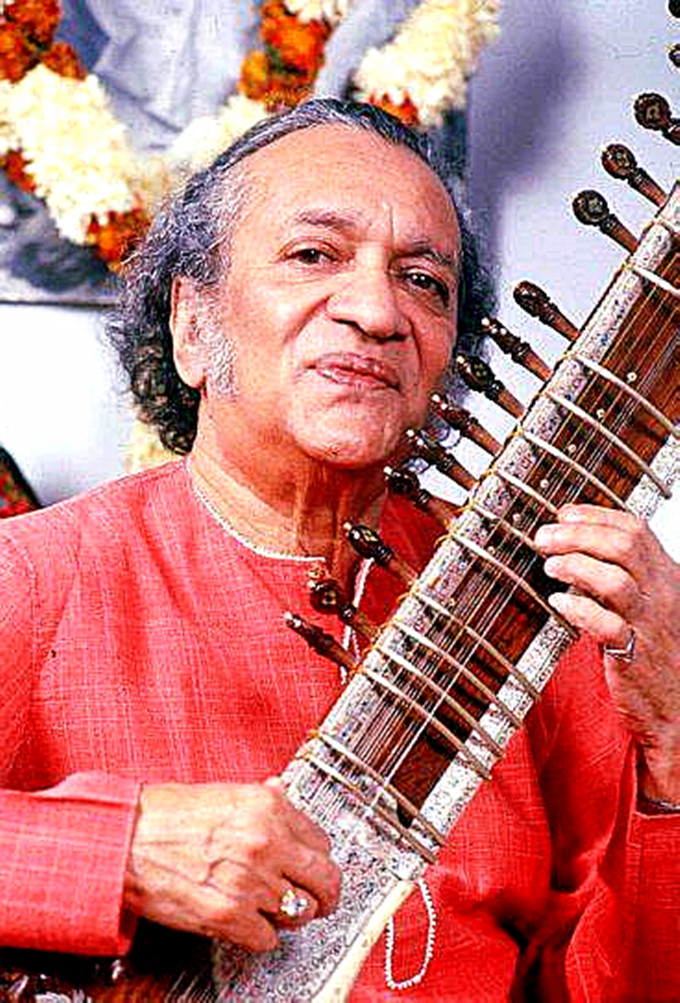 |
|
|
|
| |
晚年的拉维·香卡(Ravi Shankar
)仍然执著音乐演奏,最后一次演奏会是2012年11月4日,他与女儿安努什卡在加州长滩演奏,演奏会后的第七天,拉维·香卡永远的离开了他无比热爱的这个世界。 |
|
|
|
| |
评论家对拉维·香卡的评述 |
|
|
|
| |
拉维·香卡的音乐是集民族性、传统性与融合性为一体的音乐。在半个多世纪的世界巡回演艺生涯中,他不仅把印度民族精神和民族文化渗透于自己无数次的艺术活动之中,而且还把印度传统音乐推向了世界。印度总理尼赫鲁曾公开表示:“年轻的拉维·香卡正在做一件好事,他作为‘文化大使’通过音乐向西方展现印度。”时至今日,他虽已年近九旬高龄,但仍然活跃在世界音乐舞台上,他是印度音乐杰出的继承者、阐释者、传播者。
作为学生,他在自己父亲般的恩师印度著名音乐家阿拉乌汀·汗的倾心教导下,度过了七年的“学徒生涯”。老师所给予他的无数教诲,让他终身难忘。以他自己在电影《拉格》(1968年)中所说:“在我们音乐的世界里,永远不能说已完成了学习,因为向老师学习的过程是永无止境的。”
作为演奏家,他以自己卓越的演出实践,使西塔尔琴这一古老的印度乐器在国际舞台上占有一席之地。他精湛的演技、高度的修养和完全投入音乐的精神使观众为之倾倒。他是世界音乐舞台上最伟大的演奏家之一。
作为作曲家,他的创作涉及多种体裁。包括民族器乐、舞蹈、电影、爱国歌曲,以及用印度民族乐器与西洋管弦乐合作的音乐等。在他创作的背后,包含着他对传统古典音乐所积蕴的深厚造诣,体现出他在西方文化影响下进行文化融合的创新探索。他的音乐不失印度音乐的传统性、民族性和纯洁性,他是世界音乐最卓越的实践者之一。
作为教育家,他努力地教授印度音乐。20世纪60年代起,他先后在孟买和洛杉矶创办自己的学校——金纳拉(Kinnara)音乐学校。他是一个具有幽默感、亲切而有热情的老师,在和学生的交流中,他无拘无束,和蔼体贴,他无微不至的关心是学生们永远都不会忘记的,他是印度最优秀的“古儒”(Guru,印度对老师的称谓)之一。
作为音乐家,香卡出版了大量的唱片、磁带、CD、VCD等,1968年和2000年两次拍摄自传体电影《拉格》和《拉维·香卡在两个世界之间》。英国BBC于世纪之交的2000年特别推出一套《拉维·香卡肖像》,这些无疑都是世界音乐文化发展史上珍贵的史料。
作为成功者,拉维·香卡获得了无数的奖项与荣誉。
20世纪50年代为电影《椅子的故事》制作的音乐在威尼斯电影节上获得了特别奖。
60年代,由于他对印度音乐和文化做出了突出贡献,获得“印度总统奖”,他和梅纽因合作的唱片《东西方相遇》获格莱美音乐奖。
70年代,他的专辑《为孟加拉国人举行的音乐会》荣获“金碟奖”。
80年代,为电影《圣雄甘地》配乐荣获奥斯卡提名;为电影《卡布里瓦拉》(Kabuliwala)配乐获得柏林电影节银熊奖;1986至1992年他成为印度国会上议院成员。
90年代,在新德里荣获“自由精神奖”;在瑞典获“地球大使”水晶奖。
在20世纪中,他前后荣获14个荣誉博士学位。
进入21世纪以来,他再获法国“最高平民奖”、英国“荣誉爵士”、美国加利福尼亚州立大学艺术博士,2002年他第三次获格莱美音乐金碟奖。他是最成功的印度音乐家之一。
作为普通人,他是一个诚实、智慧、有思想、幽默、有灵感并乐观的传奇式人物。他的女儿安努什卡在自己的书中写到:“爸爸是一个近乎完美的人——天才、演奏家、作曲家、教育家、慈善家……面对这些他总是那么的不以为然,这正是他最伟大的品质之所在。”
从1930年至2005年,拉维·香卡举办了近千场的音乐会,参加了不计其数的世界音乐文化交流活动,与东西方的音乐家共同创作、表演、研讨、沟通,架起世界音乐交流之桥梁。系统而深入地研究拉维,香卡的艺术生涯和艺术成就,不仅让人们更加认识印度音乐、认识拉维·香卡,而且对如何保持中国的传统音乐、如何在世界上进一步弘扬中国音乐文化具有借鉴意义。 |
|
|
|
| |
|
|
|
|
| |
 |
|
| |
拉维·香卡(Ravi Shankar
)演奏时永远是陶醉在印度古典音乐里 |
|
|
|
| |
拉维·香卡大师与中国 |
|
|
|
| |
中央音乐学院陈自明教授曾于1982年6月在《乐器》杂志发表一篇《西塔尔琴与拉维·香卡》的文章。可以说,这是中国第一篇专门介绍香卡的文章。1983年拉维·香卡访问中国,在北京和上海分别举行了演出和讲学。针对这次访华,陈自明在1984年第1期《人民音乐》上再次发表文章《拉维·香卡——来自印度的音乐使者》。他在文中写道:“拉维·香卡在中央音乐学院的讲学也是十分成功的,他以朴实无华的语言向听众解释了印度古典音乐的两大支柱——‘拉格’和‘塔拉’,并且以自己的歌声和乐器介绍了‘拉格’的实例。接着他又同鼓手米什拉先生合作,用拟声语和鼓声的实例介绍了‘塔拉’。最后他还亲自教大家练习印度的各种‘塔拉’,取得了很好的效果。”“他也期待在不久的将来能用西塔尔与中国民族乐器进行合作,从而促成一次‘东方(音乐)与东方(音乐)的相遇’。”至此,中国音乐界才有更多的学者开始了解这位著名的印度西塔尔琴演奏大师。虽然关注度有所增加,但拉维·香卡的中文资料仍旧不足,只是在一些书籍或教材中有少量的介绍和评述,缺乏深入的分析和全方位的论述,专题性的研究则更是一项空白。 |
|
|
|
| |
Professor
Chen Ziming of The Central Conservatory of Music published an article
"Sitar and Ravi Shankar" in The magazine Musical Instruments in June
1982.It can be said that this is the first article in China devoted to
Shanka.In 1983, Ravi Shankar visited China and gave performances and
lectures in Beijing and Shanghai respectively.In response to his visit
to China, Chen published his article Ravi Shankar -- A Musical Messenger
from India in the first issue of People's Music in 1984."Ravi Shankar's
lectures at the Central Conservatory of Music were also very
successful," he wrote. "He explained to the audience the two pillars of
Classical Indian music, the Raga and the Tala, in plain language, and
introduced the examples of the Raga with his own voice and
instruments.Then, in collaboration with Mr. Mishra, the drummer, he
introduced 'Tara' with examples of onomatopoeia and drumbeat.In the end,
he himself taught the various Indian 'talas', with good results.""He
also looks forward to using Sitar to collaborate with Chinese folk
instruments in the near future, thus facilitating an 'East meets
East'."At this point, more scholars in The Chinese music industry began
to understand the famous Indian Sitar maestro.Despite the increased
attention, ravi Shankar's Chinese materials are still insufficient, with
only a few introductions and comments in some books or textbooks,
lacking in-depth analysis and comprehensive discussion, and the thematic
research is even a blank. |
|
|
|
| |
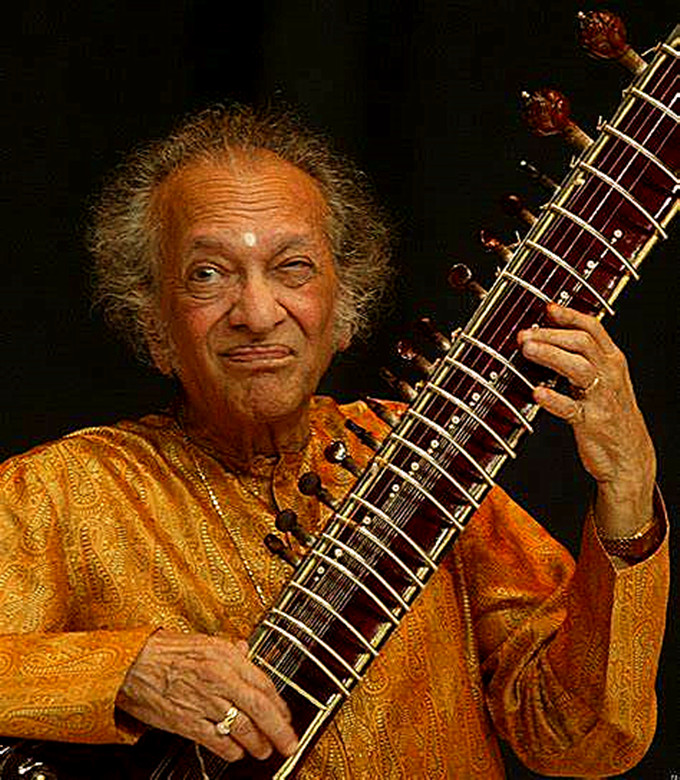 |
|
| |
晚年的拉维·香卡(Ravi Shankar
)仍然对他热爱的印度音乐不离不弃 |
|
|
|
| |
香卡最后一次演出是2012年11月4日,他与女儿安努什卡在加州长滩演奏。
香卡离世的噩耗,无数印度人为之扼腕叹息。总理辛格第一时间给香卡的遗孀发去吊唁信:“拉维·香卡大师的离去使印度失去了一个杰出的儿子,音乐界陨落了一颗璀璨的巨星……他的伟大精神随同他的音乐跨过了国家的界限,超越了艺术的疆界,惠及整个人类文明。
|
|
|
|
| |
Shankar's last
performance was with his daughter Anushka in Long Beach, Calif., on
November 4, 2012.
The death of Shankar was mourned by millions of Indians.Prime Minister
Manmohan Singh was among the first to send a letter of condolence to
Shankar's widow: "Guru Ravi Shankar's death has deprived India of an
outstanding son, and the music industry has lost a brilliant
star...Along with his music, his great spirit transcends national
boundaries and artistic boundaries, benefiting all human civilizations. |
|
|
|
| |
|
|
|
|
| |
Today in the
history of music
Indian music legend Ravi Shankar died on December 11, 2012 in
California, US, at the age of 92.
Ravi Shankar (April 07, 1920.07-December 11, 2012) The most admired
great messenger of Indian music, godfather of Indian classical music,
master of Sidar, "teacher of Famous Beatles guitarist George Harrison
and father of jazz star Norah Jones", but this is not his true glory.
In fact, as early as half a century ago, he was regarded as a generation
of Sitar master, the great messenger of Indian music and culture, and
immortal musician of the world. In terms of playing the Sitar, India's
most traditional and complex instrument with the most mysterious sound,
the world was no better.
RaviShankar -- the father of the famous jazz musician Norah Jones and
the teacher of the famous Beatles guitarist George Harrison -- was born
in the northeastern Indian city of Varanaci (formerly known as Benaras)
in 1920 to a Brahmanic family. His brother UdayShankar was a famous
Indian dancer.
At the age of 10, ravi was exposed to Western music by performing in the
West with an Indian dance troupe, and later studied Indian classical
music under the guru, ustadal-Laudinkhan, a famous Indian performer,
composer and guru.
Ravi began his playing career in the 1940s, hosted the All India Radio
band from 1949 to 1956, and produced a lot of music. After 1956, Ravi
began to tour Europe and the United States with great success, during
which he also established an Indian music school in Los Angeles.
Ancient and mysterious Indian music through ravi's introduction into the
European and American common people.
After the Beatles invited Ravi to perform together in 1960, the western
rock generation took guitar playing to a new level by drawing on its
unique sitar playing techniques.
Ravi's performance of the Sitar is a bold innovation based on the
inheritance of traditional playing skills. It is he who rejuvenates the
old musical instrument of the Sitar.
Indian music legend Ravi Shankar died on December 11, 2012 in
California, US, at the age of 92.
[1]2 Career editor After living in international fame in the 1960s,
became an ambassador for Indian music and culture.
But only a few listeners could grasp the richness of the work of the
81-year-old modern musician.
Ravi Shankar's musical talents were evident as early as his youth, when
he made his way on to the world stage, from the Carnegie Hall in New
York to the Champs-Elysees in Paris, where he worked as a dancer and
musician in a variety of troupes.
The family had already won the admiration and admiration of great
artists, including the Russian ballerina Anna Pavlova and the Irish
writer James Joyce.
Ravi Shankar and his family lived long enough in Europe and the United
States to become familiar with the likes of Jessica Heyfetz, Arturo
Toscanini, Pablo Casals, Duke Ellington, Louis Armstrong and Cabo
Carloway.
Perhaps an early upbringing in art, combined with ravi Shankar's
prodigious musical talent, insatiable passion for learning and natural
thirst for knowledge, made Panditji (" the Venerable Master ", as he was
often called) an exceptional musician-scientist as well as an
exceptional one.
With his series of appearances at Woodstock and Monterey festivals, and
his work with the Beatles (especially George Harrison), countless
musicians have seen Ravi Shankar as a contact for the world beyond the
European and American artists.
There is no doubt that the pilgrim has exposed the classical music of
North India to the ears of many people who have never heard of any other
kind of music. He has also used his extraordinary talent and fame to
combine seemingly unrelated musical elements from all over the world.
Using melodies and rhythms as raw materials, Shankar creates a bridge
between the thin air of the concert hall and everyday life.
He takes the form and influence of music and uses experimental elements
to express and depict the most universal and powerful human emotions in
the world -- joy, desire, sorrow, devotion, hope and love.
Three of Shankar's most influential cross-cultural works were recorded
under independent labels: In the Kremlin (1978), Passage (1990), which
he collaborated with composer Philip Glass, and Body and Mind (1990),
recorded by his friend and student George Harrison.
Inspired by recording technology development, incense stuck in Tanamana
(" body and mind ") in the record, the north Indian ancient musical
instrument west tal harp, such a pipa nou for piano and blah hand drum
tower are there any other south Indian Musical Instruments together,
cooperate with the keyboard and synthesizer electronic music elements,
created like his other record of successful works.
It was recorded by him in collaboration with his friend and student
George Harrison, who played the electric harp and synthesizer.
Shankar's younger sister lakshmi Shankar, one of India's best and most
popular singers, helped shankar with her heavenly voice.
His younger son Shubho also sings and plays the Sitar on the record.
He has so many things going for him: great ambassador of Indian music,
godfather of Indian classical music, Master of the Sithar, mentor to
Beatles guitarist George Harrison, three Grammy Awards and one Oscar
nomination for best Music, Member of the Upper House of India,
philanthropist, writer...
Shankar has won three Grammy Awards and been nominated for an Oscar for
the score to the film Mahatma Gandhi. He has also been awarded the Order
of the State of India, The Special Award of the Venice Film Festival,
the Silver Bear Award of the Berlin Film Festival, the Highest Civilian
Award of France, the Honorary Knight of the United Kingdom, and has 15
honorary doctorates.
West tal jean
The Sitar is a traditional musical instrument in northern India. It is
about 90 cm long. Its sound box is made of a large gourd with a mahogany
panel.
West tal jean usually has about 20, 18 to 20 strings, in one of the
seven main strings, have 4 to play the melody with strings, tuning C, G,
C, f, the other 3 for the tonic chord bass strings, to highlight the
music rhythm and tone quality in the arch below there are 11-13 parallel
resonance string, the root and the string when playing the resonance and
a natural overtone string with the string change.
It is not difficult to see that the Sitar is so complex in structure
that it is much more difficult to play than any string instrument in the
East or the West.
However, Sithar is a great instrument in the treasure house of human
music because of its soft color, highly developed playing skills and
rich and varied techniques of expression, which enable it not only to
step out of the slow and melodious lyric melody, but also to play the
fast and dynamic dance rhythm.
Ravi Shankar has been an artist for more than 70 years. He has made
great achievements in performance, creation and theory. He has published
a large number of CDS, VCDS and DVDS, and created dozens of raga songs
with different styles, as well as a large number of film music and dance
music.
Both his unique playing personality and his creative style of seeking
novelty and change have exerted an important influence on the
development of Indian music.
Today's video: 1. Sitar master Ravi Shankar playing Indian classical
music Raag Khamaj;
2. Ravi Shankar, a national treasure of India, and Aralaka jointly
explained and demonstrated the Gongs and drums of South Asia;
3. Menuin played Indian classical music with Ravi Shankar;
4. Documentary of Ravi Shankar, the godfather of Indian classical music
and master of sitar (1970). |
|
|
|
| |
|
|
|
|
| |
|
|
| |
【塔布拉鼓独奏】印度国宝级大师拉维·香卡与阿拉拉卡共同解说及示范南亚锣鼓经,當年非常有名的一个桥段了
Jhaptal(十拍子节奏模式) |
|
|
|
| |
|
|
| |
梅纽因与拉维·香卡合作演奏印度古典音乐 |
|
|
|
| |
印度古典音乐中最具有魅力的就是西塔尔。大约18世纪左右传入北印度。瑠特类拨奏弦鸣乐器,琴身共鸣箱呈葫芦状。是长颈弹拨乐器,长90厘米,红褐色琴体,其共鸣箱为一个镶上了薄木板的大葫芦。有7根弦,4根演奏主旋律、3根是共鸣箱。另外有20根辅助共鸣弦与主旋律平行。大约有20品。演奏时有丰富的音色变化和技巧,重视装饰音和滑音的运用。 |
|
|
|
| |
The most
charming piece of Indian classical music is Sitar.
It was introduced to northern India around the 18th
century. The Rute is a plucked stringed instrument
with a gourd-shaped resonator box on its body. It is
a long-necked plucked instrument, 90 centimeters
long, with a reddish-brown body. Its resonator is a
large gourd inlaid with thin wooden boards. There
are 7 strings, 4 of which play the main melody and 3
are resonators. In addition, there are 20 auxiliary
resonant strings parallel to the main melody. There
are approximately 20 items. When performing, there
are rich variations in timbre and techniques, with
an emphasis on the application of ornamental notes
and glissandos. |
|
|
|
| |
|
|
| |
印度古典音乐教父——西塔琴大师拉维·香卡的纪录片(1970) |
|
|
|
| |
西塔琴大师Ravi
Shankar,1970的音乐纪录片 |
|
|
|
| |
|
|
|
|
| |
未得原作者编者授权严禁转载www.mt77.com任何内容 |
|
|
|
|
|
|
|
|
|
|
|
l |
|
|



